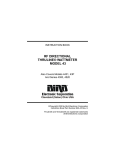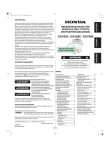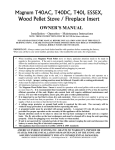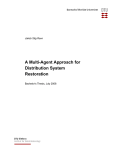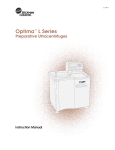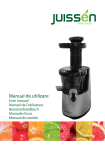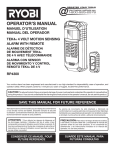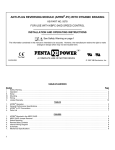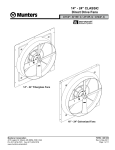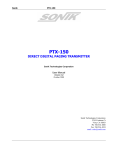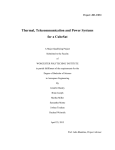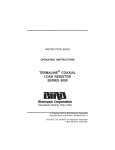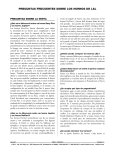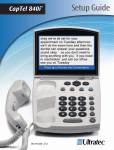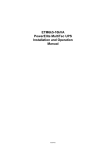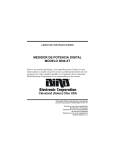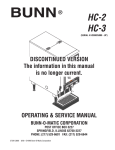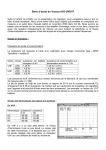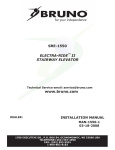Download Operation Manual - Aero Express, Inc.
Transcript
RF Directional Thruline® Wattmeter Model 43 Also Covers Models 4431, 43P And Series 4300 and 4520 OPERATING INSTRUCTIONS ©Copyright 2011 by Bird Electronic Corporation Instruction Book Part Number 920-43 Rev. K Thruline® and Termaline® are registered trademarks of Bird Electronic Corporation THIS PAGE INTENTIONALLY LEFT BLANK Safety Precautions The following are general safety precautions that are not necessarily related to any specific part or procedure, and do not necessarily appear elsewhere in this publication. These precautions must be thoroughly understood and apply to all phases of operation and maintenance. WARNING Keep Away From Live Circuits Operating Personnel must at all times observe general safety precautions. Do not replace components or make adjustments to the inside of the test equipment with the high voltage supply turned on. To avoid casualties, always remove power. WARNING Shock Hazard Do not attempt to remove the RF transmission line while RF power is present. WARNING Do Not Service Or Adjust Alone Under no circumstances should any person reach into an enclosure for the purpose of service or adjustment of equipment except in the presence of someone who is capable of rendering aid. WARNING Safety Earth Ground An uniterruptible earth safety ground must be supplied from the main power source to test instruments. Grounding one conductor of a two conductor power cable is not sufficient protection. Serious injury or death can occur if this grounding is not properly supplied. WARNING Resuscitation Personnel working with or near high voltages should be familiar with modern methods of resuscitation. WARNING Remove Power Observe general safety precautions. Do not open the instrument with the power on. iii Safety Symbols WARNING Warning notes call attention to a procedure, which if not correctly performed, could result in personal injury. CAUTION Caution notes call attention to a procedure, which if not correctly performed, could result in damage to the instrument. The caution symbol appears on the equipment indicating there is important information in the instruction manual regarding that particular area Note: Calls attention to supplemental information. Warning Statements The following safety warnings appear in the text where there is danger to operating and maintenance personnel, and are repeated here for emphasis. WARNING Leaking RF energy is a potential health hazard. Never attempt to connect or disconnect equipment from the transmission line while RF power is being applied. Severe burns, electrical shock, or death can occur. On page 11. WARNING When working with RF powers of 200 watts or more, the potential of the center conductor of the line section will be over 100 volts. Do not touch the center conductor while RF power is on. On page 13. Caution Statements The following equipment cautions appear in the text and are repeated here for emphasis. CAUTION For low reflection measurements, do not rotate the reflected power element to read forward power. Damage to the element or wattmeter could result. On page 7. iv CAUTION Handle elements with care. Calibration could be disturbed if they are dropped. On page 11. CAUTION Do not attempt to remove the RF center conductor. This will damage the line section. On page 20. v Safety Statements USAGE ANY USE OF THIS INSTRUMENT IN A MANNER NOT SPECIFIED BY THE MANUFACTURER MAY IMPAIR THE INSTRUMENT’S SAFETY PROTECTION. USO EL USO DE ESTE INSTRUMENTO DE MANERA NO ESPECIFICADA POR EL FABRICANTE, PUEDE ANULAR LA PROTECCIÓN DE SEGURIDAD DEL INSTRUMENTO. BENUTZUNG WIRD DAS GERÄT AUF ANDERE WEISE VERWENDET ALS VOM HERSTELLER BESCHRIEBEN, KANN DIE GERÄTESICHERHEIT BEEINTRÄCHTIGT WERDEN. UTILISATION TOUTE UTILISATION DE CET INSTRUMENT QUI N’EST PAS EXPLICITEMENT PRÉVUE PAR LE FABRICANT PEUT ENDOMMAGER LE DISPOSITIF DE PROTECTION DE L’INSTRUMENT. IMPIEGO QUALORA QUESTO STRUMENTO VENISSE UTILIZZATO IN MODO DIVERSO DA COME SPECIFICATO DAL PRODUTTORE LA PROZIONE DI SICUREZZA POTREBBE VENIRNE COMPROMESSA. SERVICE SERVICING INSTRUCTIONS ARE FOR USE BY SERVICE TRAINED PERSONNEL ONLY. TO AVOID DANGEROUS ELECTRIC SHOCK, DO NOT PERFORM ANY SERVICING UNLESS QUALIFIED TO DO SO. SERVICIO LAS INSTRUCCIONES DE SERVICIO SON PARA USO EXCLUSIVO DEL PERSONAL DE SERVICIO CAPACITADO. PARA EVITAR EL PELIGRO DE DESCARGAS ELÉCTRICAS, NO REALICE NINGÚN SERVICIO A MENOS QUE ESTÉ CAPACITADO PARA HACERIO. vi WARTUNG ANWEISUNGEN FÜR DIE WARTUNG DES GERÄTES GELTEN NUR FÜR GESCHULTES FACHPERSONAL. ZUR VERMEIDUNG GEFÄHRLICHE, ELEKTRISCHE SCHOCKS, SIND WARTUNGSARBEITEN AUSSCHLIEßLICH VON QUALIFIZIERTEM SERVICEPERSONAL DURCHZUFÜHREN. ENTRENTIEN L’EMPLOI DES INSTRUCTIONS D’ENTRETIEN DOIT ÊTRE RÉSERVÉ AU PERSONNEL FORMÉ AUX OPÉRATIONS D’ENTRETIEN. POUR PRÉVENIR UN CHOC ÉLECTRIQUE DANGEREUX, NE PAS EFFECTUER D’ENTRETIEN SI L’ON N’A PAS ÉTÉ QUALIFIÉ POUR CE FAIRE. ASSISTENZA TECNICA LE ISTRUZIONI RELATIVE ALL’ASSISTENZA SONO PREVISTE ESCLUSIVAMENTE PER IL PERSONALE OPPORTUNAMENTE ADDESTRATO. PER EVITARE PERICOLOSE SCOSSE ELETTRICHE NON EFFETTUARRE ALCUNA RIPARAZIONE A MENO CHE QUALIFICATI A FARLA. vii RF VOLTAGE MAY BE PRESENT IN RF ELEMENT SOCKET - KEEP ELEMENT IN SOCKET DURING OPERATION. DE LA TENSION H.F. PEAT ÊTRE PRÉSENTE DANS LA PRISE DE L'ÉLÉMENT H.F. - CONSERVER L'ÉLÉMENT DANS LA PRISE LORS DE L'EMPLOI. HF-SPANNUNG KANN IN DER HF-ELEMENT-BUCHSE ANSTEHEN ELEMENT WÄHREND DES BETRIEBS EINGESTÖPSELT LASSEN. PUEDE HABER VOLTAJE RF EN EL ENCHUFE DEL ELEMENTO RF MANTENGA EL ELEMENTO EN EL ENCHUFE DURANTE LA OPERACION. IL PORTAELEMENTO RF PUÒ PRESENTARE VOLTAGGIO RF TENERE L'ELEMENTO NELLA PRESA DURANTE IL FUNZIONAMENTO. viii About This Manual This manual covers the operating and maintenance instructions for the following models: 43 43P 4301 4521 4522 4526 4305A 4431 4527 Changes to this Manual We have made every effort to ensure this manual is accurate. If you discover any errors, or if you have suggestions for improving this manual, please send your comments to our Solon, Ohio factory. This manual may be periodically updated. When inquiring about updates to this manual refer to the part number and revision on the title page. Literature Contents Chapter Layout Introduction — Describes the features of the 43 Wattmeter, lists equipment supplied and optional equipment, and provides power-up instructions. Theory of Operation — Describes how the 43 Wattmeter works and Installation — Describes how to set up and prepare the 43 Wattmeter for use. Operation - All instructions necessary to operate the equipment appears in this chapter. Maintenance — Lists routine maintenance tasks as well as troubleshooting for common problems. Model Differences — Describes how each indivdual models vary from each other. Specifcations — Specifications and parts information are included in this chapter. ix Table of Contents Safety Precautions . . . . . . . . . . . . . . . . . . . . . . . . . . . . . . . . . . . . . . . . iii Safety Symbols . . . . . . . . . . . . . . . . . . . . . . . . . . . . . . . . . . . . . . . . . . . . . . . . . . iv Warning Statements . . . . . . . . . . . . . . . . . . . . . . . . . . . . . . . . . . . . . . . . . . . . . iv Caution Statements . . . . . . . . . . . . . . . . . . . . . . . . . . . . . . . . . . . . . . . . . . . . . . iv Safety Statements . . . . . . . . . . . . . . . . . . . . . . . . . . . . . . . . . . . . . . . . . . . . . . . vi About This Manual . . . . . . . . . . . . . . . . . . . . . . . . . . . . . . . . . . . . . . . . ix Changes to this Manual . . . . . . . . . . . . . . . . . . . . . . . . . . . . . . . . . . . . . . . . . . . ix Chapter Layout . . . . . . . . . . . . . . . . . . . . . . . . . . . . . . . . . . . . . . . . . . . . . . ix Chapter 1 Introduction . . . . . . . . . . . . . . . . . . . . . . . . . . . . . . . . . . . . . 1 Purpose and Function . . . . . . . . . . . . . . . . . . . . . . . . . . . . . . . . . . . . . . . . . . . . 1 Performance Characteristics and Capabilities . . . . . . . . . . . . . . . . . . . . . . . . . 1 Chapter 2 Theory of Operation. . . . . . . . . . . . . . . . . . . . . . . . . . . . . . . 3 Travelling Wave Viewpoint . . . . . . . . . . . . . . . . . . . . . . . . . . . . . . . . . . . . . . . . 3 Formulas . . . . . . . . . . . . . . . . . . . . . . . . . . . . . . . . . . . . . . . . . . . . . . . . . . . . 3 Forward . . . . . . . . . . . . . . . . . . . . . . . . . . . . . . . . . . . . . . . . . . . . . . . . . . . 3 Reflected . . . . . . . . . . . . . . . . . . . . . . . . . . . . . . . . . . . . . . . . . . . . . . . . . . 3 Coupling Circuit . . . . . . . . . . . . . . . . . . . . . . . . . . . . . . . . . . . . . . . . . . . . . . . . . 3 Load Power . . . . . . . . . . . . . . . . . . . . . . . . . . . . . . . . . . . . . . . . . . . . . . . . . . . . 4 Standing Wave vs. Travelling Wave Viewpoint (ρ vs. φ) . . . . . . . . . . . . . . . . 5 Low Reflection Measurements . . . . . . . . . . . . . . . . . . . . . . . . . . . . . . . . . . . . . 7 Transmitter Monitoring . . . . . . . . . . . . . . . . . . . . . . . . . . . . . . . . . . . . . . . . . . 8 Component Testing . . . . . . . . . . . . . . . . . . . . . . . . . . . . . . . . . . . . . . . . . . . . . . 8 Measuring Insertion Loss . . . . . . . . . . . . . . . . . . . . . . . . . . . . . . . . . . . . . . 9 Frequency Response . . . . . . . . . . . . . . . . . . . . . . . . . . . . . . . . . . . . . . . . . . . . . 9 Impedance Mismatch . . . . . . . . . . . . . . . . . . . . . . . . . . . . . . . . . . . . . . . . . . . 10 Chapter 3 Installation . . . . . . . . . . . . . . . . . . . . . . . . . . . . . . . . . . . . . 11 Connections . . . . . . . . . . . . . . . . . . . . . . . . . . . . . . . . . . . . . . . . . . . . . . . . . . . 11 Replacing Quick-Change Connectors . . . . . . . . . . . . . . . . . . . . . . . . . . . . 11 Remote Installation . . . . . . . . . . . . . . . . . . . . . . . . . . . . . . . . . . . . . . . . . . . . . 12 Chapter 4 Operating Instructions . . . . . . . . . . . . . . . . . . . . . . . . . . . 13 Normal Operation . . . . . . . . . . . . . . . . . . . . . . . . . . . . . . . . . . . . . . . . . . . . . . 13 Load Matching . . . . . . . . . . . . . . . . . . . . . . . . . . . . . . . . . . . . . . . . . . . . . . . . . 17 Chapter 5 Maintenance . . . . . . . . . . . . . . . . . . . . . . . . . . . . . . . . . . . . 19 Troublehshooting . . . . . . . . . . . . . . . . . . . . . . . . . . . . . . . . . . . . . . . . . . . . . . 19 Cleaning . . . . . . . . . . . . . . . . . . . . . . . . . . . . . . . . . . . . . . . . . . . . . . . . . . . . . . 20 Contact Adjustment . . . . . . . . . . . . . . . . . . . . . . . . . . . . . . . . . . . . . . . . . . . . 20 xiii Zero Adjust . . . . . . . . . . . . . . . . . . . . . . . . . . . . . . . . . . . . . . . . . . . . . . . . . . . . Storage . . . . . . . . . . . . . . . . . . . . . . . . . . . . . . . . . . . . . . . . . . . . . . . . . . . . . . . Customer Service . . . . . . . . . . . . . . . . . . . . . . . . . . . . . . . . . . . . . . . . . . . . . . . Bird 43 Replacement Parts List . . . . . . . . . . . . . . . . . . . . . . . . . . . . . . . . . . . . Bird 43 Replacement Parts List . . . . . . . . . . . . . . . . . . . . . . . . . . . . . . . . . Available “QC” Type Connectors . . . . . . . . . . . . . . . . . . . . . . . . . . . . . . . . . . 21 21 22 23 23 25 Chapter 6 Model Differences . . . . . . . . . . . . . . . . . . . . . . . . . . . . . . . 27 Bird 43P Peak Wattmeter . . . . . . . . . . . . . . . . . . . . . . . . . . . . . . . . . . . . . . . . 27 Operation . . . . . . . . . . . . . . . . . . . . . . . . . . . . . . . . . . . . . . . . . . . . . . . . . . 27 Peak Detector Response . . . . . . . . . . . . . . . . . . . . . . . . . . . . . . . . . . . . . . 27 Rectangular Pulses . . . . . . . . . . . . . . . . . . . . . . . . . . . . . . . . . . . . . . . . . . 27 Peak Calibration . . . . . . . . . . . . . . . . . . . . . . . . . . . . . . . . . . . . . . . . . . . . . 28 Maintenance . . . . . . . . . . . . . . . . . . . . . . . . . . . . . . . . . . . . . . . . . . . . . . . 28 Bird 4301 Thruline Wattmeter . . . . . . . . . . . . . . . . . . . . . . . . . . . . . . . . . . . . 29 Bird 4305A Thruline Wattmeter . . . . . . . . . . . . . . . . . . . . . . . . . . . . . . . . . . . 29 Bird 4305A Replacement Parts List . . . . . . . . . . . . . . . . . . . . . . . . . . . . . 30 Bird 4431 Thruline Wattmeter . . . . . . . . . . . . . . . . . . . . . . . . . . . . . . . . . . . . 31 Maintenance . . . . . . . . . . . . . . . . . . . . . . . . . . . . . . . . . . . . . . . . . . . . . . . 31 Bird 4431 Replacement Parts List . . . . . . . . . . . . . . . . . . . . . . . . . . . . . . 32 Customer Replacement Parts . . . . . . . . . . . . . . . . . . . . . . . . . . . . . . . . 32 Service Only Replacement Parts . . . . . . . . . . . . . . . . . . . . . . . . . . . . . . 33 Bird 4520 Series Thruline Wattmeters . . . . . . . . . . . . . . . . . . . . . . . . . . . . . . 33 Installation . . . . . . . . . . . . . . . . . . . . . . . . . . . . . . . . . . . . . . . . . . . . . . . . . 33 Operation . . . . . . . . . . . . . . . . . . . . . . . . . . . . . . . . . . . . . . . . . . . . . . . . . . 33 Bird 4520 Series Replacement Parts List . . . . . . . . . . . . . . . . . . . . . . . . . 34 4521 Replacement Parts . . . . . . . . . . . . . . . . . . . . . . . . . . . . . . . . . . . . 34 4522 Replacement Parts . . . . . . . . . . . . . . . . . . . . . . . . . . . . . . . . . . . . 34 4526/27 Replacement Parts . . . . . . . . . . . . . . . . . . . . . . . . . . . . . . . . . 35 Service Only Replacement Parts . . . . . . . . . . . . . . . . . . . . . . . . . . . . . . 35 Chapter 7 Specifications. . . . . . . . . . . . . . . . . . . . . . . . . . . . . . . . . . . 37 Limited Warranty . . . . . . . . . . . . . . . . . . . . . . . . . . . . . . . . . . . . . . . . . 39 xiv xv Chapter 1 Introduction Purpose and Function The 43 is an insertion-type RF wattmeter, designed to measure RF power and load match in 50 ohm coaxial transmission lines. It is intended for use with CW, AM, FM, and TV modulation, but not pulse modulation. When used in 50 ohm applications, the 43 has a maximum VSWR of 1.05 for frequencies up to 1000 MHz. The meter provides direct readings in watts with an expanded scale for easy reading. The scale is graduated for 25, 50, and 100 full scale. Elements are available in a variety of power and frequency ranges (see the Bird Electronic Corporation Catalog for details). This manual covers the operation of the Bird 43 Thruline Wattmeter and its descendants. Two models have RF sampler ports, while the Bird 43P can measure peak power. The Bird 4520 series comes ready for panel mounting. Differences are discussed in Chapter 6, on page 27. Except where indicated, instructions and specifications for the 43 apply to other models also. Performance Characteristics and Capabilities The Bird 43 is portable, with an attached carrying strap. It has an aluminum housing and an easily removed back cover, with bumpers on the base and back that allow the meter to stand or lie flat. For additional protection, the microammeter is specially shock mounted. A slotted screw on the lower front face of the meter is used to zero the pointer. Below the meter face, the RF line section protrudes slightly from the wattmeter housing with the element socket in the center. A shielded cable connects the RF line section to the rest of the wattmeter. This lets you remove the line section from the wattmeter housing for custom installation and still make measurements. The RF line section is precision machined to provide the best possible impedance match to the transmission line under test. A formed phosphor-bronze spring finger protrudes into the element socket to make contact with the element. At each end of the line section are Bird Quick-Change RF connectors that may be interchanged with any other Bird “QC” connector. The wattmeter housing does not interfere with connector changes. To make measurements, a Bird Plug-In Element is inserted into the line section socket and rotated against one of the stops. A small catch in the corner of the socket face presses on the shoulder of the element to keep it in proper alignment. This assures good contact between the spring finger and the element contact and between the lower edge of the element and the line section body (see Figure 1). 1 Figure 1 Securing an element Contacts on opposite sides of the element connect with the spring finger when the element is in the forward or reverse position. This occurs when the stop pin on the element is against either stop and the catch is in place. Figure 2 2 Bird 43 Thruline Wattmeter Outline Drawing Chapter 2 Theory of Operation Travelling Wave Viewpoint The easiest way to visualize Thruline operation is from a travelling wave viewpoint. In transmission lines the voltages, currents, standing waves, etc., on any uniform line section result from the interaction of two travelling waves: • • Forward Wave (and its power) travels from the source to the load. It has RF voltage Ef and current If in phase, with Ef / If = Zo. Reflected Wave (and its power) originates by reflection at the load and travels from the load back to the source. It has an RF voltage Er and current Ir in phase, with Er / Ir = Zo. Formulas Each wave is mathematically simple and has a constant power: Forward 2 2 2 2 W f = WattsForward = E f ⁄ Z o = I f Z o = E f L f Reflected W r = WattsReflected = E r ⁄ Z o = I r Z o = E r L r Note: Zo is the characteristic impedance of a uniform line section. For useful lines it is usually a pure resistance of 50 ohms. The RF circuit of the Bird 43 is a length of uniform air line with Zo = 50 ohms. Coupling Circuit The coupling circuit that samples the travelling waves is in the Bird Plug-In Element. The element circuitry and its relationship to the rest of the Bird 43 are illustrated in Figure 3. 3 Figure 3 Thruline Wattmeter Schematic Current is produced in the coupling circuit by the travelling waves in the line section. Both inductive and capacitive coupling contribute to this. The inductive current flows in the direction of the travelling wave. The capacitive current is independent of the direction of the travelling wave. Therefore, the inductive current produced by one of the travelling waves will add in phase with the corresponding capacitive current, while that produced by the wave travelling in the opposite direction will subtract. The additive or “arrow” direction is assigned to the forward wave. The electrical characteristics of the element are carefully adjusted so that, for the reverse travelling wave, the inductive current will completely cancel the capacitive current. The result is directivity greater than 25 dB. Thus, the element is sensitive at either of its settings, but to only one of the two travelling waves. Thruline Wattmeter measurements are also independent of position along the transmission line. Like similar diode devices, the Bird 43 indicates the carrier component of amplitude modulation, with very little response to side band components added by modulation. Load Power For loads with a VSWR of 1.2 or less, the power dissipated in a load (Wl) is equivalent (with less than one percent error) to the forward power (Wf). When appreciable power is reflected, as with an antenna, it is necessary to use the exact load power which is given by: W 1 = WattsIntoLoad = W f – W r Good load resistors, such as Bird Termaline loads, will give negligible reflected power. 4 Standing Wave vs. Travelling Wave Viewpoint (ρ vs. φ) As mentioned previously, the Thruline Wattmeter reacts to forward and reverse travelling waves to measure power in a transmission line. The standing wave viewpoint, also widely used, is highly developed both in theory and in practice. This viewpoint can be traced to the early use of slotted transmission lines. The slotted line measures the standing wave ratio by mechanically positioning a voltage detector at peaks and nulls along a length of line section. Its drawbacks are that it is usually too long, too expensive for good accuracy, not portable, and too slow. These problems grow rapidly as the measurement frequency drops below 1000 MHz. The Thruline Wattmeter by comparison is fast, convenient, and accurate. It provides the same information as a slotted line with the exception of the phase angle of the reflection coefficient (distance, load to minimum). The simple relationships: 1+ φ ρ = ---------------1– φ and ρ–1 φ = -----------ρ+1 2 Note: Where r = VSWR and f = Wr / Wf These can be used to convert between the standing wave ratio (ρ) and the reflected/forward power ratio (φ), which can be directly read from the Thruline Wattmeter. The relationship between ρ and φ is graphed in Figure 4 and Figure 5. Note: Attenuation, measured in dB, can be derived from the power ratio by the equation Ndb = 10 log φ. VSWR scales and their attendant controls for setting the reference point have been intentionally omitted from the Bird 43. Experience using the Thruline Wattmeter for transmitter tune-up, antenna matching, etc. will show that the power ratio measurement is as useful in practice as the standing wave ratio. A trial is suggested – forget about VSWR for a few days and think in terms of φ = Wr / Wf. The two meter readings, Wr and Wf, give a useful, approximate picture of the results without bothering to calculate the power ratio exactly. Consider that, for an antenna matching problem, the main objective usually is to minimize Wr. Anything done experimentally to this end will be seen when the element is turned to the reflected power position. 5 Figure 4 6 Percent Reflected Power vs. VSWR (1.0 – 1.3) Figure 5 Percent Reflected Power vs. VSWR (1.0 – 8.0) Low Reflection Measurements φ = 10% (ρ = 2) is the typical limit of antenna match. Further effort is frequently not worthwhile because below this level reflected power is hard to measure, and Wl can not be significantly increased. TV and VHF transmitters are examples of systems requiring lower reflected power but for reasons other than maximizing power transmission. CAUTION For low reflection measurements, do not rotate the reflected power element to read forward power. Damage to the element or wattmeter could result 7 When the same element is used to measure both forward and reflected power, meaningful readings are possible down to about φ = 5% (ρ = 1.5). For accurate measurement of very low levels of reflected power, i.e. φ = 0.6% (ρ = 1.17), use a second element rated at one tenth of the full scale power of the forward element. This method should not be used with element ranges differing by more than 10:1. Example - Consider an 80 watt transmitter and a Bird 43 with 100 and 10 watt elements. Measure Wf with the 100 W element. Measure Wr using the 10 W element (with the arrow pointing towards the transmitter). Wr can be measured down to at least 0.5 W, so that φ = 0.5 / 80 or about 0.6%, corresponding to ρ = 1.17. Transmitter Monitoring The Thruline Wattmeter can be used for the continuous monitoring of transmitter output or reflected power, for instance in checking intermittent antenna or line faults. Component Testing The Bird 43 is very helpful in component testing, and may be employed in several ways: • • VSWR or φ may be measured by placing the component under test between the wattmeter and a good load resistor. Attenuation (power lost by heat in a line) as well as VSWR may be measured by inserting the unknown line between two Thruline wattmeters, or between a Thruline wattmeter and a Termaline absorption wattmeter. Note: Very small attenuations require allowance for normal instrument errors. To correct for this without any calculations, simply connect the wattmeters directly, with no line between them, and adjust their zero settings until they are both zeroed. • 8 Line loss using open circuit calibration: The high directivity of elements can be exploited in line loss measurements, because of the equality of forward and reflected power with the load connector open or short circuited. In this state the forward and reflected waves have equal power, so that φ = 100% and ρ = ∞. Open circuit testing is preferred to short circuit, because a high quality open circuit is easier to create than a high quality short. Measuring Insertion Loss 1. 2. 3. Check forward and reverse power equality with a high quality open circuit, Connect an open-circuited, unknown line to the wattmeter. Measure the line twice (once down and once back). Note: The measured φ is the attenuation for two passes along the line. 4. Compare the attenuation with published data for line type and length (remember to halve Ndb or double the line length to account for the measurement technique). Note: This measurement should be supplemented by either time domain reflectometry or DC continuity and leakage checks, since the attenuation measurement alone cannot account for faults such as open or short circuits partway down the line. Note: Tery small attenuations require allowance for normal instrument errors. Make sure to note exact readings, or their difference, on the initial equality check, and correct for this. Frequency Response Bird Plug-In Elements have a flat frequency response over their specified operating range. A sample set of curves is shown in Figure 6. Notice that for the low power element, the rolloff outside its frequency band is more pronounced than for the high power elements. Example - At 40 MHz the 10C element will have a loss of 4 dB, giving a reading of about 40% of the true value For the 100C, the loss will only be about 1 dB, for a reading at 80% of the true value, and the 500C should be within the normal 5% of full scale tolerance. Figure 6 Representative Frequency Response 9 These curves are typical for all element types (H, A, B, C, D, ...) at their respective frequencies. Since a C type element has a frequency range of 100 - 250 MHz, response curves for other element types can be approximated by replacing the 100 and 250 MHz points on the chart with the extremes of the element’s frequency range, and recalc-ulating the other frequency points accordingly. Example - For a B element (range 50 - 125 MHz) simply divide all frequencies by two. For an E element (range 400 1000 MHz) multiply all frequencies by four. Harmonics or subharmonics that lie outside of the frequency range of the element may exist in the circuit under test. A rough approximation of the element’s response to harmonics can be made with these curves. Using an element for measurements outside of its frequency range is not recommended. The response curves presented are only typical, and not guaranteed. Impedance Mismatch There may be cases where it is necessary to use the Bird 43 with a non-50 ohm transmission line. If the reflected power is less than 10% and the frequency is below 200 MHz, the resulting mismatch will not be too serious. At higher test frequencies and/or higher reflected power levels, the load impedance will change when the wattmeter is removed from the circuit. When the line and load impedances are known, the system’s VSWR equals the ratio of the two. Always divide the larger impedance by the smaller, since VSWR must always be greater than 1. Example - Consider using a Bird 43 to tune a 70 ohm line. If the load impedance is also 70 ohms, the wattmeter will measure a VSWR of 70/50 = 1.4. However, if the wattmeter is removed, the VSWR will actually be 1.0. Similarly, if the load impedance is 35.7 ohms, the VSWR will be 50/35.7 = 1.4 with the wattmeter and 70/35.7 = 2.0 without it. Caution must therefore be used, since both good and bad matches can have the same measured VSWR. In this case, the correct impedance can be determined by slightly changing the load impedance. When the load impedance is near 70 ohms, the Bird 43 will read increasing VSWR as the load impedance is increased. Note: When working with non-50 ohm lines, it is especially important to calculate the load power by subtracting the reflected power from the forward power. 10 Chapter 3 Installation When transporting the Bird 43, insert the original dust plug, or an element with the arrow pointing upward, in the element socket and secure with the catch. This will shunt the meter circuit and protect the meter by dampening needle action during handling and shipping. Also, secure spare elements in their sockets with the pivoting knob; just insert the element and twist the knob one-quarter turn. CAUTION Handle elements with care. Calibration could be disturbed if they are dropped. Connections WARNING Leaking RF energy is a potential health hazard. Never attempt to connect or disconnect equipment from the transmission line while RF power is being applied. Severe burns, electrical shock, or death can occur. Insert the Bird 43 in coaxial transmission lines of 50 ohms nominal impedance. The RF source can be connected to either side of the wattmeter without affecting readings. If non-50 ohm cables are used, a mismatch will occur causing inaccuracies in readings. However, if a mismatch cannot be avoided, refer to "Impedance Mismatch" on page 10 for instructions. It is strongly advised that this condition be avoided. The Bird 43 is normally supplied with Quick-Change Female N type connectors. Other Bird “QC” connectors are available, refer to the Replacement Parts List in the Maintenance Chapter. Replacing Quick-Change Connectors 1. 2. 3. Remove the 8-32 screw at each corner of the connector Pull it straight outward. Install the new connector by reversing Steps 1 and 2. 11 Remote Installation 1. 2. 3. 4. Note: To replace the RF line section, reverse these steps. Unscrew the four 8-32 flat head screws securing the back cover. Grasp the back cover by the side tabs behind the line connectors and pull straight back to remove it. Remove the two 10-32 oval screws on the front of the housing. Slide the line section out of the housing. Note: Do not loosen the two oval screws on the sides of the housing in line with the meter. These hold the shock ring in place. 5. Replace the cable attaching the line section to the meter with one of sufficient length to complete the remote installation. In some systems it may be desirable to have two or more line sections permanently installed. In this case, one set of elements and one meter can be used to measure several separate RF transmission lines. Additional RF line sections are available. The RF line section of the Bird 43 lends itself very readily to panel mounting. A layout for the panel cut is given in Figure 7. The thickness of the panel should be about 1⁄4 inch. On thinner panels, build up the thickness with pads or washers to achieve a flush-face mounting. Attach the line section so that the finger catch is in the most accessible position. Figure 7 12 Panel Cut for Mounting RF Body Chapter 4 Operating Instructions WARNING When working with RF powers of 200 watts or more, the potential of the center conductor of the line section will exceed 100 volts. Do not touch the center conductor while RF power is on. The Bird 43 uses plug-in elements to make measurements. The element’s frequency range and maximum power are listed on its label. The transmitter test frequency should be within the band of the element used. See "Frequency Response" on page 9 for information on using the elements outside of their specified frequency range. The arrow on the element indicates directional sensitivity; i.e., the direction of power flow that the meter will read. Rotate the element to select forward or reverse power measurement. Combining the Thruline Wattmeter with a Bird Termaline Load Resistor creates an accurate absorption wattmeter. With this combination, readings only need to be taken in the forward direction because the reflected power will be negligible. Normal Operation 1. 2. 3. 4. Insert the appropriate element in the line section socket. Turn the element so that the arrow points towards the load to measure forward power and towards the source for reflected power. Turn on the RF source. Read the power using the scale whose full-scale marking matches the element’s maximum power. 13 Figure 8 Element Direction When readings are being made with the wattmeter connected to an auxiliary RF line section, do not put an element in the unused line section. Otherwise, the DC circuit will be unbalanced or shorted, causing inaccurate or zero power readings. For convenience, a set of VSWR conversion nomographs is included in this manual. With these charts, VSWR may be determined from the forward and reflected power readings. Find the intersection of the forward and reflected power measurements. The slanted line passing closest to this point indicates the VSWR. 14 Figure 9 VSWR Conversion Graph (Reflected Power 0.2 – 20.0) 15 Figure 10 16 VSWR Conversion Graph (Reflected Power 0.01 – 1.00) Load Matching When a Bird 43 is used to tune a load to a transmitter and a good match is obtained, removing the unit will not change the match quality. A good 50 ohm load can terminate a 50 ohm transmission line of any length without altering conditions at the transmitter. The 43 is just an extra length of 50 ohm line in series with the measurement. When the load is not well matched (an antenna with a VSWR of 1.5 or 2.0) the line length between the load and the transmitter will transform the load impedance as seen at the transmitter. Removing the wattmeter shortens the total line length by four inches plus two connectors. This is still not significant at low frequencies where five inches is a small fraction of a wavelength, but at higher frequencies the frequency or power output of the transmitter may be affected. Transmission line theory shows that if the line length changes by exactly 1⁄2 wavelength, the impedance is unchanged. To have identical match with the wattmeter in or out of the circuit, insert or remove 1⁄2 wavelength of line (including the unit). To do this, use a length of cable which, when added to the unit, equals a 1⁄2 wavelength at the frequency of interest. If multiple frequencies are needed, a separate cable length is required for each. See Figure 11 for sample cable lengths. Note: Cable length is measured from end to end of the connector’s outer conductor, except for UHF or mini-UHF plugs where the length is measured from tip to tip of the center pins. Note: Dimensions shown are for solid polyethylene cable like RG-58C/U or RG-8/U, which have a velocity of propagation 66% of that of air. If RG-58 or RG-8 type cables containing foam poly-ethylene (velocity of propagation of 79%) are used, the dimensions in the graph must be multiplied by the ratio of the relative velocities; 79% ÷ 66% = 1.2 in this case. 17 Figure 11 18 Cable Length / Wavelength Matching Chapter 5 Maintenance The rugged and simple design of the Bird 43 means that it requires minimal routine maintenance. Troublehshooting The following table contains troubleshooting information for problems that can occur during normal operation. Find the problem on the table, review possible causes, and perform the corrective action listed. This manual does not list all malfunctions that may occur, or all corrective actions. If a malfunction is not listed or not corrected by the listed actions, contact the nearest Bird Service Center for assistance. Problem No meter reading Intermittent or inconsistent meter reading High VSWR or reflected power Possible Cause Corrective Action No RF power Check RF source “Arrow” on element pointing wrong way Rotate element DC contact bent Adjust contact (page 20) Open or short circuit in meter Replace defective cable (RG-58/U) Meter burned out or damaged Return wattmeter for service Dirty DC contact on element Clean contact (page 20) Faulty transmission line or antenna Inspect line Sticky or defective meter Return wattmeter for service Foreign material in line section or in RF connector Clean connectors (page 20) Open or shorted transmission line Inspect line Bad load or poor connectors Inspect load, antenna, and connectors 19 Cleaning It is important to keep the following surfaces clean: • • • Socket bore DC contacts on the element Teflon insulators If any of the contacts or line connectors are dirty, clean them with a cotton swab dipped in commercial contact cleaner or isopropyl alcohol. CAUTION Do not attempt to remove the RF center conductor. This will damage the line section. If the RF line section seems dirty, do not loosen any connections. Clean accessible components as described above and use dry, clean air to blow out the interior. The outside of the meter housing can be cleaned with a soft cloth dampened with a mild detergent solution. Do not wipe the meter glass with a dry cloth, or a static charge could develop that would cause an erroneous meter indication. Contact Adjustment When cleaning the socket bore, do not disturb the spring finger of the DC contact. If necessary, the contact can be adjusted manually. The button must be out far enough to maintain good contact, but not so far as to interfere with easy entry of the element body. To remove the DC jack and spring finger: 1. Unscrew both 4-40 fillister head screws holding the jack assembly against the side of the RF line section. 2. Retract the assembly. Note: Be careful not to lose the small teflon bead that straddles the base of the spring and nests in a counterbore on the side of the line section. 3. Replace the assembly. Note: Make sure that the bead is properly inserted) and the two screws. 20 Zero Adjust The meter’s zero setting should be checked when no RF power is present. When no power is applied the pointer should rest exactly on zero. If adjustment is required, turn the adjustment screw until the pointer is set at zero (see Figure 12). Figure 12 Zero Adjust Storage When storing the meter, keep an element or dust plug in the element socket to prevent the intrusion of dust and to prevent damage to the meter movement. When using an element, use the highest power element available. Turn it so that the “arrow” points up (midway between the FWD and RFL positions). This protects the meter and will not expose the element diode to dangerous potentials should the line section be energized. 21 Customer Service Any maintenance or service procedure beyond the scope of those in this chapter should be referred to a qualified service center. If the unit needs to be returned for any reason, request an RMA through the Bird Technologies website. All instruments returned must be shipped prepaid and to the attention of the RMA number. Bird Service Center 30303 Aurora Road Cleveland (Solon), Ohio 44139-2794 Fax: (440) 248-5426 E-mail: [email protected] For the location of the Sales Office nearest you, visit our Web site at: http://www.bird-technologies.com 22 Bird 43 Replacement Parts List Note: See “Customer Replacement Parts” on page 32 Description Qty. Part Number Housing Assembly 1 4210-018 Cover Assembly 1 4210-005-1 Line Section Assembly 1 4230-018 Carrying Strap 1 8580A003 Dust Plug, Aluminum 1 3610-031 DC Connector Assembly 1 4230-010 DC Connector 1 7500-076 Microammeter 1 2080-002 Coaxial Cable Assembly 1 4220-097-1 Turnbutton 2 4300-015 Spring Washer 2 5-1144-1 Rubber Stem Bumper 8 5-1388 Pushnut 2 5-1076-1 Replacement Meter Kit 1 8-000 RF Connectors 2 See list on next page Bird 43 Replacement Parts List Customer Replacement Part RPK43-1 - Housing Kit RPK43-2 - Rear Cover Kit RPK43-3 - Line Section Kit RPK43-4 - Meter Kit Consists of 4210-018 923-RPK43-1 4210-005-1 923-RPK43-2 4230-018 923-RPK43-3 8-000 4220-087 923-RPK43-4 Description Housing Instruction Sheet Cover Instruction Sheet Line Section Instruction Sheet Replacement Meter Shock Mount Instruction Sheet 23 Customer Replacement Part RPK43-5 - External Hardware Kit Consists of 1118-0614-00 1120-0820-00 1136-0813-00 5-1388 5-1763 8240-054 8580A003 923-RPK43-5 24 Description #8-32x3/8 Phillips Flathead Machine Screw #10-32x1/2 Phillips Oval Screw #10-32x1/2 Phillips Pan Screw Rubber Bumper Stem Gray Rubber Bumper Foot Strap Spacer Screw Plastic Handle Instruction Sheet Available “QC” Type Connectors Connector Part Number Connector Part Number BNC-Female 4240-125 Open Term. # 10-32 Nut 4240-363 BNC-Male 4240-132 SC-Female 4240-090 C-Female 4240-100 SMA-Female 4240-336 C-Male 4240-110 SMA-Male 4240-334 HN-Female 4240-268 TNC-Female 4240-156 HN-Male 4240-278 TNC-Male 4240-160 LC-Female 4240-031 UHF-Female 4240-050 LC-Male 4240-025 UHF-Male 4240-179 LT-Female 4240-018 7/16” IEC (Jack) Type 169-4 4240-344 LT-Male 4240-012 7/16” IEC (Plug) Type 169-4 4240-080 Mini UHF-Female 4240-346 7/8” EIA 4240-002 N-Female 4240-062 1-5/8” EIA Fixed 4240-096 N-Male 4240-063 1-5/8” EIA Swivel 4240-208 25 26 Chapter 6 Model Differences Bird 43P Peak Wattmeter The Bird 43P Thruline Wattmeter is the same as the Bird 43, with the added capability of measuring peak power in AM, SSB, and some pulse applications. A conversion kit (P/N 4300-400) is available to give peak reading capability to any standard Bird 43. This kit comes with all necessary parts and easy to follow instructions for simple and quick conversion. Special elements are not required. However, the element power rating must match the peak power to be measured. Example - If 1000 watt peaks are expected, use a 1000 watt element. Operation There is a push button on/off switch on the right side of the meter. • • To read peak power, push the switch in. The red LED will light. To read CW power, push the switch again. The LED will turn off. Peak Detector Response Since the peak detector’s response time is about one second, a short delay may be noticed before the meter reading stabilizes. This will also be noticed when the transmitter is turned off. In voice modulated systems, the meter reading may fluctuate by 2–3 minor scale divisions as the peak detector attempts to follow the power variations. Rectangular Pulses When measuring rectangular pulse power, note the following signal requirements: • • • Duty Cycle: 2%, minimum Rep. Rate: 100 pps, minimum Pulse Width: 200 µs, minimum 27 Peak Calibration If recalibration is required, refer to figure 15 and these instructions: 1. Unscrew the four 8-32 flat head screws securing the back cover. 2. Grasp the back cover by the side tabs behind the line connectors and pull straight back to remove it. 3. Insert the Bird 43P between a reliable CW signal source and a 50 ohm load. 4. Insert an element with the appropriate power and frequency range into the Bird 43P. Turn it to read forward power. 5. Set the wattmeter to CW mode (LED off). 6. Turn on the signal source and adjust the source power to give a stable reading in the upper half of the wattmeter’s scale. 7. Switch the wattmeter to PEAK mode (LED on). 8. Adjust the potentiometer (R9) until the PEAK reading is the same as the CW reading. 9. Replace the back cover. Maintenance Maintenance of the Bird 43P is the same as for the Bird 43 except for battery replacement. Battery life should typically be 48 hours. If the unit does not function properly in peak mode or if calibration cannot be achieved, the batteries may be low. Replace with two new 9 V alkaline or lithium batteries. The batteries fit very tightly in their retaining clips and may have to be pried out one at a time. Figure 13 Model 43P U1 + + - + 28 Bird 4301 Thruline Wattmeter The Bird 4301 Thruline Wattmeter is the same as the Bird 43 except for the following physical differences: The auxiliary DC connector on the Model 4301 can be used to connect to an accessory line section. Make the connection with a standard RG-58/U cable. Bird 4305A Thruline Wattmeter The Bird 4305A Thruline Wattmeter is the same as the Bird 43 except for the following physical differences: • • • • The Bird 4305A’s dimensions are 4-5/16”L x 4”W x 6-7/8”H (110 x 102 x 175 mm), including element and bumper feet. The Bird 4305A’s weight is 3.25 lb. (1.5 kg), including the element. The Bird 4305A does not have holders for spare elements. The Bird 4305A line section has higher operating power capability and is 1-5/8” in diameter, instead of 15/16” as in the Bird 43. Theory, maintenance, and all instructions for the Bird 43 also apply to the Bird 4305A. 29 Bird 4305A Replacement Parts List Customer Replacement Part RPK4305-1 - Housing Kit RPK4305-2 - Rear Cover Kit RPK4305-3 - Line Section Kit RPK4305-4 - Meter Kit RPK4305-5- External Hardware Kit Consists of 4305A003 RPK4305-5 923-RPK4305-1 4305A002 1118-0419-00 923-RPK4305-2 4305-005 923-RPK4305-3 2150A015-1 4220-097-22 923-RPK4305-4 1116-0400-00 1120-0819-00 4285-002-4 923-RPK4305-5 30 Description Housing, Meter Assembly External Hardware Kit Instruction Sheet Cover Assembly #8-32x1/4 Phillips Screw Instruction Sheet Line Section Assembly Instruction Sheet Meter 25/50/100W Cable, Coax/Assy 48 in Instruction Sheet #6-32X1/4 Pan Screws #10-32x1/2 Phillips Screws Clamp Spacer Instruction Sheet Bird 4431 Thruline Wattmeter The Bird 4431 RF Sampling Wattmeter is the same as the Bird 43 Thruline Wattmeter except for an RF signal sampler probe. The RF sampler provides a low power sample of the signal being transmitted through the wattmeter’s linesection. This signal is available at the female BNC connector labeled “RF SAMPLE”, on the right side of the housing. The signal level can be set with the control knob on the front of the meter. The table below lists approximate attenuation levels, and notes maximum suggested adjustment. The sampler output may be fed to any suitable RF signal monitoring device; e.g. a frequency counter, spectrum analyzer, or oscilloscope. All other operation instructions are the same as for the Bird 43. Sampler at max (Fully clockwise) Turned counterclockwise 4 full turns from max* Turned counterclockwise 7 full turns from max* Freq. (MHz) Freq. (MHz) Freq. (MHz) Atten. (dB) Atten. (dB) Atten. (dB) 2 69 300 38 800 36 10 57 400 34 900 35.5 25 46 500 30 1000 35 50 42 600 29.5 75 39 700 29 100 36 800 28.5 200 31 900 28 * Approximate attenuation Maintenance Do not make repairs to the probe assembly. If the sampler malfunctions, we recommend returning the unit to the Bird Service Center for repair. To replace the probe assembly, follow these instructions: 1. 2. 3. Access the probe by unscrewing the four 8-32 flat head screws that secure the back cover. Grasp the back cover by the side tabs behind the line connectors and pull straight backward to remove it. Remove the small coupling control knob on the front of the wattmeter with a 1/16 hex socket wrench. 31 4. 5. 6. 7. 8. Remove the two 8-32 x 1/4” screws fastening the guide and plate assembly to the back of the line section. Put the control knob back on the shaft, then turn it counterclock-wise until the collar is free of the shaft. Remove the control knob. Pull the probe plate straight out of the pin and guide bushing. Unscrew the 5/8 hex nut on the BNC connector and pull the sampler connector into the case. The probe plate assembly, P/N 4431-003, is now released and may be replaced. Note: The sampler cable (RG-58/U) center conductor is soldered to the probe’s rear stub. The cable is secured to the side sleeve of the probe with the same screw used in the dc connector plug assembly, P/N 7500-076. It may be removed by unscrewing the 3/8 hex screw, unsoldering the lead tip and pulling out the cable. The probe assembly is formed into the socket and is not replaceable. 9. Replace by carefully reversing the above procedure. Note: When inserting the control bushing, be sure the alignment pin is properly positioned. Bird 4431 Replacement Parts List Customer Replacement Parts Customer Replacement Part RPK4431-1 - Housing Kit RPK4431-2 - Guide Plate, Line Section Kit RPK4431-3 - Meter Kit RPK43-4 - Meter Kit 32 Consists of Description 4431-033 RPK4431-4 4431-002 4431-007 4431-003 923-RPK4431-2 4230-018 923-RPK43-3 2080-002 5-1066 4220-097-1 4220-087 4410A261 923-RPK4431-3 Housing Instruction Sheet Plate, Guide, Assembly Line Section Assembly Plate, Movable Assembly Instruction Sheet Line Section Instruction Sheet Meter Assembly Strip, Shock 12 in Coax Cable Mount, Shock Assembly Pad, Neoprene Shock Instruction Sheet Customer Replacement Part RPK4431-4 - External Hardware Kit Consists of Description 8580A003 5-1388 5-1763 1120-0820-00 1118-0614-00 1138-0813-00 4431-035 8240-054 5-1193 923-RPK4431-4 Handle, Plastic Bumper, Stem Rubber Bumper Ft, Gray Rubber #10-32x1/2 Phil Screws #8-32x3/8 Phil Screws #10-32x1/2 Phil Screws Label, RF Sample Spacer, Strap, Screw Knob, Knurled BLK Instruction Sheet Service Only Replacement Parts Replacement Part RP3610-031 RP2080-002 RP4300-015 RP5-1388 Consists of 3610-031 (5 per) 2080-002 4300-015 5-1388 Description Aluminum Dust Plug 25/50/100W Mater Molded Turnbutton Rubber Bumper Stem Bird 4520 Series Thruline Wattmeters The Bird 4520 RF Thruline Wattmeters (models 4521, 4522, 4526, 4527) are the same as the Bird 43, except that they are panel mounted for rack installation. In addition, the Bird 4527 has a RF sampler. These units are intended for fixed installation, generally in rack mounts requiring 19” panels. Installation 1. Choose a location allowing easy reading and operation of the unit and where the cables used will be short and without sharp bends. Note: Avoid the use of angles and adapters. 2. 3. Make sure all connectors are tightened securely. Use four 12-24 screws to fasten the wattmeter panel to the rack. Operation The RF sampler on the Bird 4527 provides a low power sample of main RF signal. This signal is available at the female BNC connector labeled “RF SAMPLE”. The sampler output may be fed to any RF signal suitable monitoring device; e.g. a frequency counter, spectrum analyzer, or oscilloscope. 33 Bird 4520 Series Replacement Parts List The mounting panel entry lists the panel styles for each model. Only parts which are not used on the Bird 43 are listed here. 4521 Replacement Parts Customer Replacement Part RPK4521-1 - Line Section Kit RPK4521-2 - Meter Kit RPK4521-3 - Front Panel Kit RPK4521-4 - External Hardware Kit Consists of Description 4230-018 923-RPK4521-1 2080-002 4220-097-5 4285-002-2 923-RPK4521-4 Line Section Assembly Instruction Sheet Meter 25/50-100W Cable, Coax/Assembly 16 in Instruction Sheet Panel, Blank Instruction Sheet #6-32x1/2 Round MS Screw #6 Split Lock Washer #6-32 Hex Nut SS #10-32x1/2 Phillips Screws Label, Safety Symbol #8-32x3/8 Phillips Screws Spacer Instruction Sheet Consists of Description 4522-002-7 4304-026 923-RPK4522-1 2080-002 5A2177 5A2154 4522-013 923-RPK4521-2 Line Section Assembly Label, Mylar Instruction Sheet Meter 25/50-100W Facenut, Beveled Switch, Toggle Cable, Assembly Instruction Sheet 923-RPK4521-2 4521-002 923-RPK4521-3 1116-0801-25 1132-0201-00 1131-0200-00 1120-0820-00 5A2315-2 1118-0614-00 4522 Replacement Parts Customer Replacement Part RPK4522-1 - Line Section Kit RPK4522-2 - Meter Kit 34 Customer Replacement Part RPK4522-3- External Hardware Kit Consists of 1116-0801-25 1132-0201-00 1131-0200-00 1120-0820-00 1132-0406-00 5A2315-2 1131-0400-00 5A2290-2 5A2290-1 923-RPK4522-3 4522-006 5A2290-2 5A2290-1 923-RPK4522-4 RPK4522-4 - Front Panel Kit Description #6-32x1/2 Round MS Screw #6 Split Lock Washer #6-32 Hex Nut SS #10-32x1/2 Phillips Screws #10 External Lock Washer Label, Safety Symbol #10-32 Hex Nut SS Label, RFL Label, FWD Instruction Sheet Panel, Mounting Label, RFL Label, FWD Instruction Sheet 4526/27 Replacement Parts Customer Replacement Part RPK2080-002 Consists of 2080-002 Description Meter 25/50-100W Service Only Replacement Parts Replacement Part Consists of 4526-004 4527-005 4527-002 4526-004 4527-005 4527-002 4430-002 4430-002 Description Panel Panel Line Section Assembly RF Cable Assembly (4527 only) 35 36 Chapter 7 Specifications These specifications include data covering the Bird 43, 43P, 4305A, 4431, 4521, 4522, 4526, and 4527. Specifications for models not listed are identical to the Bird 43. Impedance, Nominal 50 ohm VSWR, Max. All models except 4431 4431 1.05:1 1.07:1 (when coupling is less than 30 dB) Connectors Primary Line RF Sampling (on applicable models) Bird “QC” (N Female normally supplied) Female BNC Power and Frequency Range (element dependent) 43,43P,4521/22/26 100 mW – 10 kW 0.45 – 2700 MHz 25 kW max, 0.45 – 2.5 MHz 10 kW max, 2 – 30 MHz 5000 W max, 2 – 30 MHz 1000 W max, 30 – 1000 MHz 1000 W max, 2 – 200 MHz 500 W max, 200 – 512 MHz 4305 4431* 4527 RF Coupling 4527 (approximate) –53 dB, 512 – 10 MHz –70 dB, 10 – 2 MHz 15 – 70 dB 4431 (adjustable) Insertion Loss (4431 only)* 2 – 512 MHz 512 – 1000 MHz 0.1 dB max 0.1 dB max Accuracy CW (all models) Peak Power (43P only) Power Requirement (43P only) Battery Life (43P only) ± 5% of full scale ± 8% of full scale Two 9V alkaline batteries (NEDA 1604) 48 hours typical Dimensions, Nominal 43, 43P 4305A 4431 4521/22/26/27 3-5/8”L x 4”W x 6-7/8”H (92 x 102 x 175 mm) 4-1/4”L x 3-7/8”W x 6-7/8”H (108 x 99 x 175 mm) 3-7/8”L x 4”W x 6-7/8”H (99 x 102 x 175 mm) 19”W x 5-1/4”H x 1-3/4”D (483 x 134 x 45 mm) 37 Approximate Weight with N-Connectors 4521/22/26/27 43, 43P, 4431 4305A Operating Position Finish 3 lb. (1.36 kg) 4 lb. (1.8 kg) 3.43 lb. (1.6 kg) Any Grey Powder Coat *. Applicable only for maximum coupling less than 30 dB. This requires a minimum decoupling of four full turns counterclockwise above 200 MHz, and seven full turns above 800 MHz 38 Limited Warranty All products manufactured by Seller are warranted to be free from defects in material and workmanship for a period of one (1) year, unless otherwise specified, from date of shipment and to conform to applicable specifications, drawings, blueprints and/or samples. Seller’s sole obligation under these warranties shall be to issue credit, repair or replace any item or part thereof which is proved to be other than as warranted; no allowance shall be made for any labor charges of Buyer for replacement of parts, adjustment or repairs, or any other work, unless such charges are authorized in advance by Seller. If Seller’s products are claimed to be defective in material or workmanship or not to conform to specifications, drawings, blueprints and/or samples, Seller shall, upon prompt notice thereof, either examine the products where they are located or issue shipping instructions for return to Seller (transportation charges prepaid by Buyer). In the event any of our products are proved to be other than as warranted, transportation costs (cheapest way) to and from Seller’s plant, will be borne by Seller and reimbursement or credit will be made for amounts so expended by Buyer. Every such claim for breach of these warranties shall be deemed to be waived by Buyer unless made in writing within ten (10) days from the date of discovery of the defect. The above warranties shall not extend to any products or parts thereof which have been subjected to any misuse or neglect, damaged by accident, rendered defective by reason of improper installation or by the performance of repairs or alterations outside of our plant, and shall not apply to any goods or parts thereof furnished by Buyer or acquired from others at Buyer’s request and/or to Buyer’s specifications. Routine (regularly required) calibration is not covered under this limited warranty. In addition, Seller’s warranties do not extend to the failure of tubes, transistors, fuses and batteries, or to other equipment and parts manufactured by others except to the extent of the original manufacturer’s warranty to Seller. The obligations under the foregoing warranties are limited to the precise terms thereof. These warranties provide exclusive remedies, expressly in lieu of all other remedies including claims for special or consequential damages. SELLER NEITHER MAKES NOR ASSUMES ANY OTHER WARRANTY WHATSOEVER, WHETHER EXPRESS, STATUTORY, OR IMPLIED, INCLUDING WARRANTIES OF MERCHANTABILITY AND FITNESS, AND NO PERSON IS AUTHORIZED TO ASSUME FOR SELLER ANY OBLIGATION OR LIABILITY NOT STRICTLY IN ACCORDANCE WITH THE FOREGOING. 39



















































